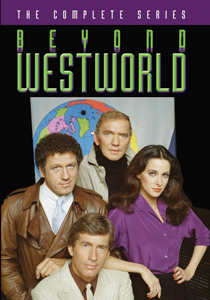On HBO’s “Westworld” – which is expected to air its fourth season later this year – robots are establishing themselves in the wider world. But it’s not the first time that’s happened in this franchise. In “Beyond Westworld” (1980, CBS), robots under the remote control of their inventor, Simon Quaid (James Wainwright), infiltrate various groups of people for nefarious reasons.
As we learn in the first of these five episodes that continue from Michael Crichton’s “Westworld” and its sequel “Futureworld,” the Delos corporation had licensed Quaid’s robots for the theme park. But Quaid became peeved about the ’bots trivial use as gunslingers and prostitutes. So he purposely had them go berserk. So we have the TV series’ formula: Delos’ agents, John Moore (Jim McMullan) and Pamela Williams (Connie Sellecca), aim to stop each of Quaid’s little schemes.
Unintentional chuckles
“Beyond Westworld” is not good by any traditional measure. But it is fun to watch. You can’t help but chuckle at the fact that a robot infiltrates a submarine, an NFL team, a rock band, a NASCAR crew and a police precinct. Moore and Williams must figure out which person is the robot, and simply observing them is not enough – this is an amusing (accidental?) commentary on how humans are robotic in some aspects of their lives.

“Beyond Westworld” (1980)
5 episodes, CBS
Creator: Lou Shaw; continuing from Michael Crichton’s movie “Westworld”
Stars: Jim McMullan, Connie Sellecca, James Wainwright
Usually, the robot ultimately reveals itself to our heroes by making an attack, as Quaid – from his remote bunker – finally decides it’s time to make a move.
Some of “Beyond’s” cheese comes from a plain ole low budget. The climactic race in “The Lion” (4) is between two cars – one with a robot, one with its intended victim. It’s clearly shot against an empty landscape, except the editors sometimes cut to stock footage of a large crowd.
At other times, the show could’ve tried a little harder. Quaid’s monitor shows what his robot is up to, but not from the robot’s point of view. Rather, he sees it like it’s a TV show, with various wide angles edited together. There is never any mention of drone cameras.
This is not only dumb, but also a missed opportunity for something that could’ve been cool, and done easily: a robot’s-eye-view of the action on the monitors.
The viewer at home sometimes gets internal robot’s-eye-view shots. Building off the groundbreaking computer-generated images in Crichton’s “Westworld” seven years prior, here the robot sees numbers, a radar image and a silhouette of its target. It hears itself making a steady machine clanking noise.
Good lead actors, actually
All of this is amusing, but it could wear thin in a hurry if not for the aspects of “Beyond Westworld” that actually are good. The main actors are either unaware they are in a bad show or their professionalism won’t let them acknowledge it.

Wainwright is particularly great. Even with every mission foiled, Quaid never raises his voice in anger. He is playing a calculated long game. His end goal is hard to argue with: He aims to install robots (who look identical to the real person they replace) in key positions across the globe. Then the robots will make good, moral decisions that humans are incapable of in the halls of power.
If this could be achieved, I for one would welcome our new robot overlords. But of course, Quaid is willing to kill people in pursuit of his end goal, so I have to root for the good guys. Luckily, the suave McMullan and the delicately pretty Sellecca make a fine duo, nicely supplemented by William Jordan as Joseph “Opp” Oppenheimer, their reliable boss back at Delos HQ.
The two leads have good chemistry, but their writing as a proto-Mulder and Scully is remarkably sloppy. Between episodes one and two, entirely off screen, Moore and Williams have a romance but break it off. Because of this, hints of tension emerge in “My Brother’s Keeper” (2).
A handful of moments remind us they care for each other. Williams rushes up to Moore, thrilled that he has survived an explosion. “I didn’t know you cared,” he says with a smirk. Later, absorbed in a mission, Moore barks out a list of orders and Williams sardonically replies “Yes, master”; he apologizes for being overzealous.
Spot the guest stars
Another pleasure of watching these five episodes (three aired, and the two unaired episodes surfaced in the 2014 DVD release) is spotting familiar actors. Most notably, Ronee Blakley (“A Nightmare on Elm Street”) fronts the band Power & Ruth in “Sound of Terror” (3). The title presumably doesn’t represent the band’s sound, which isn’t half-bad, and we get substantial portions of multiple songs.
“Star Trek” legend George Takei pops up in “Takeover” (5). Weirdly, it’s a small role as a robot doctor, and Takei is not prominently billed; you’d think the promoters would want to draw the “Trek” audience. (Of course, the episode did not air anyway.) “Cobra Kai” fans will smile at seeing Martin Kove as a hotheaded police officer in this same episode.
I could’ve stood another handful of “Beyond” episodes just to see what other random groups Quaid bizarrely decides to infiltrate with his robots. But I can’t criticize the 1980 TV-viewing public too much for rejecting this show; it’s hard to imagine sticking with it for seasons on end.
But with the success of the new “Westworld” series, “Beyond Westworld” has gained status as a historical curiosity. Watching these five episodes is, from that angle, a fun experience.

